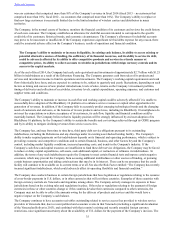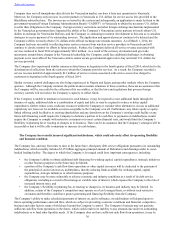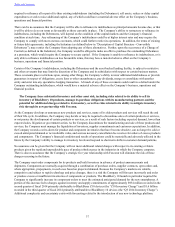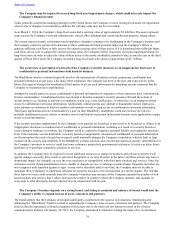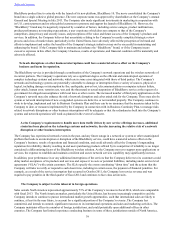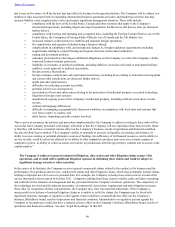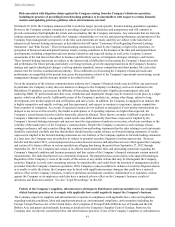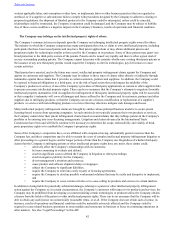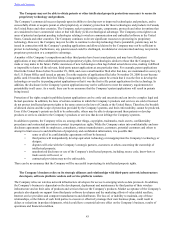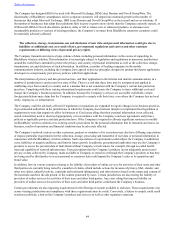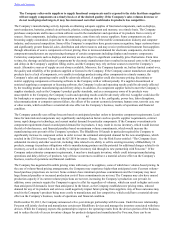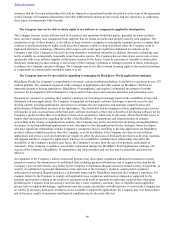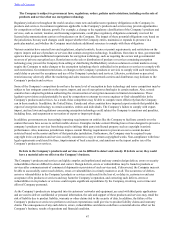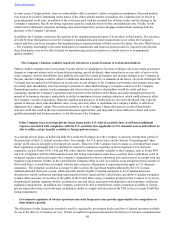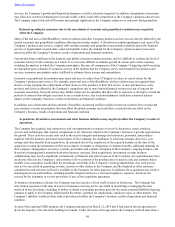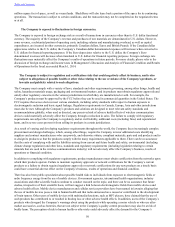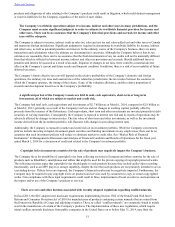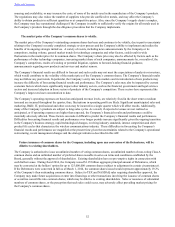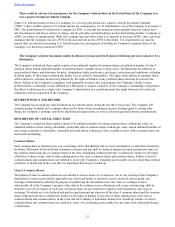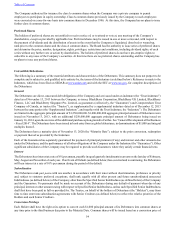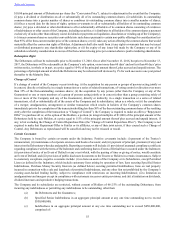Blackberry 2014 Annual Report Download - page 53
Download and view the complete annual report
Please find page 53 of the 2014 Blackberry annual report below. You can navigate through the pages in the report by either clicking on the pages listed below, or by using the keyword search tool below to find specific information within the annual report.
45
The Company relies on its suppliers to supply functional components and is exposed to the risks that these suppliers
will not supply components on a timely basis or of the desired quality; if the Company’s sales volumes decrease or
do not reach projected targets, it may face increased costs that could make its products less competitive.
The Company’s manufacturing activity depends on obtaining adequate supplies of functional components, such as displays,
semi-conductors, batteries, printed circuit boards, plastics, tooling equipment and memory, on a timely basis. The Company
purchases components and licenses certain software used in the manufacture and operation of its products from a variety of
sources. Some components, including custom components, come from sole source suppliers. Some components are also
becoming supply constrained, in part due to the continuing convergence of the mobile communication industry and computer
industry, and increased competition. Some of the Company’s competitors have greater name recognition, larger customer bases
and significantly greater financial, sales, distribution and other resources and may receive preferential treatment from suppliers
through allocations of scarce components or lower pricing. Due to increased demand for electronic components, electronic
component manufacturers are experiencing shortages of certain components including displays and memory components.
Certain key components such as displays and memory are also subject to significant commodity price fluctuations. From time
to time, the shortage and allocation of components by electronic manufacturers have resulted in increased costs to the Company
and delays in the Company’s suppliers filling orders, and the Company may rely on these sources to meet the Company’s
needs. Alternative sources of supply are not always available. Moreover, the Company depends on, but has limited control over,
the quality and reliability of the products supplied or licensed to the Company. If the Company cannot manufacture and supply
products due to a lack of components, or is unable to redesign products using other components in a timely manner, the
Company’s sales and operating results could be adversely affected. A supplier could also increase pricing, discontinue or
restrict supplying components or licensing software to the Company with or without penalty. If a supplier discontinued or
restricted supplying a component or licensing software, the Company’s sales and operating results could be adversely affected
by the resulting product manufacturing and delivery delays. In addition, if a component supplier failed to meet the Company’s
supplier standards, such as the Company’s product quality standards, and as a consequence some of its products were
unacceptable to the Company, the Company’s sales and operating results could be adversely affected. A supplier could also file
for bankruptcy or experience damage or interruption in its operations due to fire, earthquake, power loss, labor disruptions,
telecommunications or computer systems failure, the effects of the current economic downturn, human error, terrorist acts, war
or other events, which could have a material adverse effect on the Company’s business, results of operations and financial
condition.
The Company generally uses rolling forecasts based on anticipated product orders to determine component requirements. Lead
times for materials and components vary significantly and depend on factors such as specific supplier requirements, contract
terms, rapid changes in technology, and current market demand for particular components. If the Company overestimates its
component requirements based on anticipated demand for its products, it may result in excess inventory, which would increase
the risk of obsolescence, and financial penalties based on minimum volume commitments, which would increase the
manufacturing costs per unit of the Company’s products. The BlackBerry 10 launch in particular required the Company to
significantly increase its component orders in order to meet the estimated anticipated demand for the new smartphones, which
resulted in the Z10 Inventory Charge and the Q3 2014 Inventory Charge. See the Risk Factor entitled: “The Company faces
substantial inventory and other asset risk, including risks related to its ability to sell its existing inventory of BlackBerry 10
products, manage its purchase obligations with its manufacturing partners and the potential for additional charges related to its
inventory, as well as risks related to its ability to mitigate inventory risk through its new partnership with Foxconn.” If the
Company underestimates component requirements, it may have inadequate inventory, which could interrupt manufacturing
operations and delay delivery of products. Any of these occurrences could have a material adverse effect on the Company’s
business, results of operations and financial condition.
The Company has negotiated favorable pricing terms with many of its suppliers, some of which have volume-based pricing. In
the case of volume-based pricing arrangements, the Company may experience higher than anticipated costs if current volume-
based purchase projections are not met. Some contracts have minimum purchase commitments and the Company may incur
large financial penalties or increased production costs if these commitments are not met. The Company may also have unused
production capacity if its current volume projections are not met, increasing the Company’s production cost per unit. In
addition, some contracts require the Company to agree to a flat fee regardless of volumes, which can result in higher unit costs
than anticipated if demand is lower than anticipated. In the future, as the Company establishes new pricing terms, reduced
demand for any of its products and services could negatively impact future pricing from suppliers. Any of these outcomes may
result in the Company’s products being more costly to manufacture and less competitive, which could have a material adverse
effect on the Company’s business, results of operations and financial condition.
On December 20, 2013, the Company announced a five-year strategic partnership with Foxconn. Under this new relationship,
Foxconn will jointly develop and manufacture certain new BlackBerry devices and manage the inventory associated with those
devices. While the Company expects this partnership to improve the operating results from the devices portion of the business,
and to reduce the risk of excess inventory charges for products designed and manufactured by Foxconn, there can be no
Table of Contents


